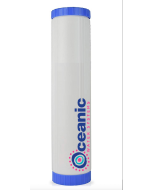Birm Media | 1 cubic Ft | Iron and Manganese Reducing Media
ADVANTAGES
• Under the proper conditions, no chemicals to purchase for maintenance. Regeneration not required.
• Iron removal efficiency is extremely high.
• Negligible labor cost: only periodic backwashing required.
• Durable material with a long life and wide temperature range.
• Weighs only 30 lbs./cu. ft.
PHYSICAL PROPERTIES
• Color: Black
• Bulk Density: 30 lbs./ cu. ft.
• Mesh Size: 10 x 40
• Specific Gravity: 2.0 gm/cc
• Effective Size: 0.48 mm
• Uniformity Coefficient: 2.7
CONDITIONS FOR OPERATION
• Alkalinity should be greater than two times the combined sulfate and chloride concentration.
• Maximum water temp: 100o F/38o C
• Water pH range: 6.8-9.0
• Dissolved Oxygen (D.O.) content must be equal to at least 15% of the iron (or iron and manganese) content.
• Bed depth: 30-36 in.
• Freeboard: 50% of bed depth (min.)
• Backwash rate: 10-12 gpm/sq. ft.
• Backwash Bed Expansion: 20-40% of bed depth (min.)
• Service flow rate: 3.5-5 gpm/sq. ft. intermittent flow rates and/or favorable local conditions may allow higher flow rates
INFLUENT AND BACKWASH LIMITATIONS
• Free chlorine concentration less than 0.5 ppm
• Oil: None Present
• Polyphosphates: None present
Birm® is an efficient and economical media for the reduction of dissolved iron and manganese compounds from raw water supplies. It may be used in either gravity fed or pressurized water treatment systems. Birm® acts as an insoluble catalyst to enhance the reaction between dissolved oxygen (D.O.) and the iron compounds. In ground waters the dissolved iron is usually in the ferrous bicarbonate state due to the excess of free carbon dioxide and is not filterable.
Birm®, acting as a catalyst between the oxygen and the soluble iron compounds, enhances the oxidation reaction of Fe++ to Fe+++ and produces ferric hydroxide which precipitates and may be easily filtered. The physical characteristics of Birm® provide an excellent filter media which is easily cleaned by backwashing to remove the precipitant. Birm® is not consumed in the iron removal operation and therefore offers a tremendous economic advantage over many other iron removal methods. Other advantages of Birm® include; long material life with relatively low attrition loss, a wide temperature performance range and extremely high removal efficiency. Negligible labor costs are involved because Birm® does not require chemicals for regeneration, only periodic backwashing is required. When using Birm® for iron removal, it is necessary that the water: contain no oil or hydrogen sulfide, organic matter not to exceed 4-5 ppm, the D.O. content equal at least 15% of the iron content with a pH of 6.8 or more.
If the influent water has a pH of less that 6.8, neutralizing additives such as Clack Corosex®, Calcite or soda ash may be used prior to the Birm® filter to raise the pH. A water having a low D.O. level may be pretreated by aeration. Additions of chemicals to influent or backwash water which contacts Birm® media may inhibit iron or manganese removal or may break down or coat Birm® media.
Chlorination greatly reduces Birm®’s activity. High concentrations of chlorine compounds may deplete the catalytic coating. Polyphosphates are known to coat Birm® and reduce Birm®’s ability to remove iron or manganese. Before adding any chemical to the influent or backwash water, the chemical's compatibility with Birm® should be thoroughly tested. Clack Birm® may also be used for manganese reduction with the same dependability as iron removal. In these applications the water to be treated should have a pH of 8.0-9.0 for best results.
If the water also contains iron, the pH should be below 8.5. High pH conditions may cause the formulation of colloidal iron which is very difficult to filter out. All other conditions remain the same for either manganese or iron removal.
| Model Number | BIRMMEDIA1CF |
|---|---|
| UPC | 0 |
| Brand | Clack |
| Item Number | 0 |
| Shipping Length | 0 |
| Shipping Width | 0 |
| Shipping Height | 0 |
| Shipping Weight | 0 |





